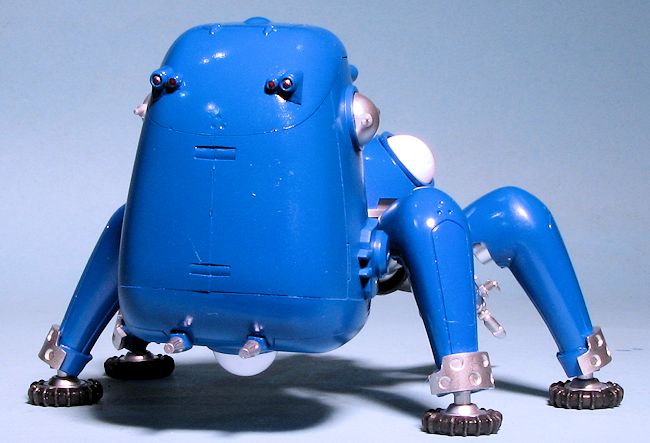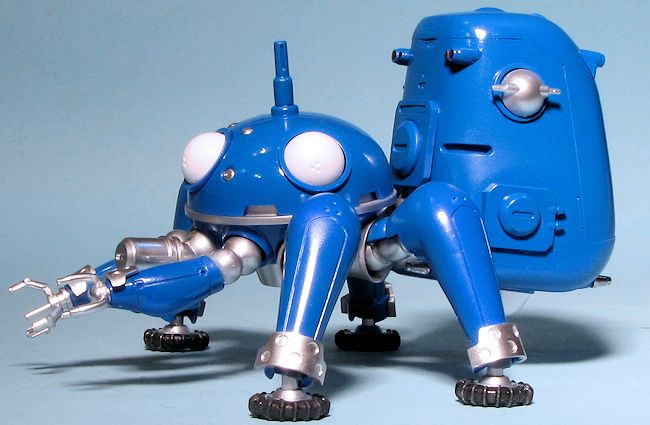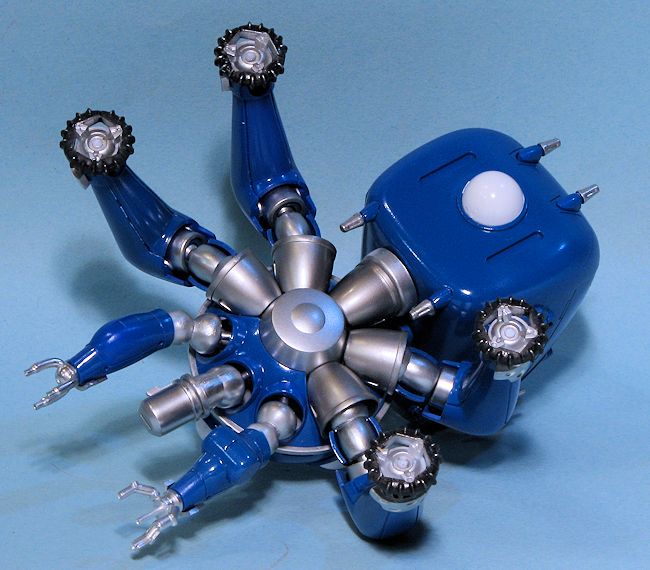
Wave 1/24 Tachikoma
| KIT #: | KK-01 |
| PRICE: | $40.00 which included shipping from Japan |
| DECALS: | None |
| REVIEWER: | Scott Van Aken |
| NOTES: | Produced in 2005. Includes Motoko Kusanagi figure. |

| HISTORY |
 A Tachikoma (タチコマ) is a fictional artificial intelligence, walker/roller in the Ghost in the Shell universe; appearing in the manga, created by Masamune Shirow, and the Stand Alone Complex sub-universe. Nine of them are assigned to Section 9's use originally. They are spider-like, multi-legged combat vehicles, equipped with artificial intelligence. The spider design appears in other places in Shirow's work, like the Appleseed manga. Shirow is noted to keep numerous spiders as pets.
A Tachikoma (タチコマ) is a fictional artificial intelligence, walker/roller in the Ghost in the Shell universe; appearing in the manga, created by Masamune Shirow, and the Stand Alone Complex sub-universe. Nine of them are assigned to Section 9's use originally. They are spider-like, multi-legged combat vehicles, equipped with artificial intelligence. The spider design appears in other places in Shirow's work, like the Appleseed manga. Shirow is noted to keep numerous spiders as pets.
Production I.G was unable to use the Fuchikoma design in the 2002 Stand Alone Complex anime TV series due to copyright conflicts. However, Masamune Shirow was able to design a legally safe equivalent to the spider-tanks for the new show, which he named the "Tachikoma". There are distinct differences in the design, most significantly in the 'eyes' and the vertically oriented abdomen. Still, the tanks are easily recognizable as descendants of the original Fuchikoma. Their AI 'personalities' and roles in the new series are indistinguishable from their predecessors in the manga.
| THE KIT |
Back around 2000 I became interested in anime. Rather a late start in life for some, but so it is. It has taken me a while to really get involved in the Ghost in the Shell (GITS) series, first only purchasing the two main movies: Ghost in the Shell (1995) and Ghost in the Shell 2: Innocence (2004). Both are excellent anime for those who might be interested. Recently, I decided to give the TV series a go and picked up the Stand Alone Complex (SAC) offerings (two seasons worth and so 52 episodes). Also the 2005 TV movie set in the SAC world, Solid State Society.
 I've always liked the machines and vehicles in sci-fi/anime and so after watching these, I looked to see if there was a model done of the A.I. tanks, the Tachikomas. Much to my delight, I found that Wave had produced one in 2005 so I started looking for one. Naturally, I found a lot at ridiculous prices, but eventually located one at a more reasonable cost so ordered it.
I've always liked the machines and vehicles in sci-fi/anime and so after watching these, I looked to see if there was a model done of the A.I. tanks, the Tachikomas. Much to my delight, I found that Wave had produced one in 2005 so I started looking for one. Naturally, I found a lot at ridiculous prices, but eventually located one at a more reasonable cost so ordered it.
What arrived was a box that included four box size colored sprues; two in blue and two in white. A smaller dark grey sprue and a tan sprue for the figure of Motoko Kusinagi were also included. These latter two are vinyl and the dark grey parts are all parts of hinges. The molding on the kit is excellent with no flash at all. It very much appears that the kit is designed like the myriad of robot kits that are so popular with younger builders. There attachment pins and sockets are very large and it may be that this is a near-snap kit.
One basically traps all the vinyl joints between pieces of arms and such, inserting the other sections into them to provide articulated joints. There are a lot of parts in the kit as there are a lot of articulated pieces, There are basically two optional settings. One is the feet, which can be splayed or one can install the wheeled versions. The forward pod can be built as shown on the box art or with the Gatling cannon.
Instructions are nicely done and in Japanese, sales outside the country not considered sufficient to warrant dual or triple language instructions. However, everything is pretty easy to understand so there should be no issues. The instruction booklet is nicely done and on the back are all the color references using Gunze paints. There is no painting information during construction, the views in the single page painting guide as well as the box art to be used for this. No decals are provided nor required.
| CONSTRUCTION |
I have never built a Japanese robot kit, but from what I've seen, they are engineered to be snap kits along with vinyl sockets for the arms and legs and such. So it seems with this kit. However, if you just snap bits together, not only will it have a plethora of seams, but it just won't be quite right. I sure don't want a snap toy on my shelf, so I took the extra effort to make it right.
 The first thing I discovered is that to keep from getting bogged down in small bits, the sprues need to be painted. Basically all the white sprues will be metallic, so I painted everything on them except the four 'eye' bits with Alclad II aluminum. Of course, this will not be the first time the parts are painted, but it makes handling them later quite a bit easier. All of the bits on the blue sprues were given a coat of Testors French Blue.
The first thing I discovered is that to keep from getting bogged down in small bits, the sprues need to be painted. Basically all the white sprues will be metallic, so I painted everything on them except the four 'eye' bits with Alclad II aluminum. Of course, this will not be the first time the parts are painted, but it makes handling them later quite a bit easier. All of the bits on the blue sprues were given a coat of Testors French Blue.
Construction consists of three major sections. The first section are all the legs, arms and the weapon pod. The main body is another section and the personnel pod at the back is the third. The instructions logically start with the appendages and that is logical as these will take a lot of your build time. The main body will end up being the last construct to be built, mostly due to the way it is engineered.
All of the appendages and the rear personnel pod will have small vinyl sockets trapped between plastic halves. These are not the easiest things to get properly aligned and took a bit of fussing to get them in place. The bits that hold the sockets all have seams that will need to be filled. For that reason alone, tight as the fit was, I still glued these parts together. All of this assembly, filler, and sanding work was time consuming as the parts are relatively small and difficult to hold while doing clean-up. One thing I noticed is that on most of the parts, the sprue attachment area was on the flat joining surface. In my experience, this only leads to larger gaps that need to be filled as I always seem to over-sand these areas removing the pips.
When painting the metallic parts, I used other colors besides straight aluminum to add a bit of interest. One has to also realize that on some pieces, what looks like a join surface will be quite visible on the completed model so all these need to be quite smooth and painted. Generally those bits that are 'cuffs' will need care to ensure all surfaces are done. I also found, when building up the personnel pods, that the small sensors are, in some cases, handed, though the part numbers are the same. I also found that some of the holes needed to be opened up to get a decent fit.
 Eventually, all the parts were painted and assembly could get underway. The 'balls' on the parts fit quite snugly into the vinyl sockets. An area where I had to do some sanding to provide any sort of a fit was when the sleeves that fit into the short part of the 'L' on the main legs were installed. These are a bit too wide and need to be sanded down a bit to fit.
Eventually, all the parts were painted and assembly could get underway. The 'balls' on the parts fit quite snugly into the vinyl sockets. An area where I had to do some sanding to provide any sort of a fit was when the sleeves that fit into the short part of the 'L' on the main legs were installed. These are a bit too wide and need to be sanded down a bit to fit.
The kit provides a number of options in terms of the weapons fit and the wheels/feet. I chose to build my Tachikoma with the wheels as that is how they were presented in the first television season. By season two they had been provided with feet and if one wishes, one can (hopefully) remove the wheels and replace them with the foot parts. As for the weapons, I chose the one with the canon covered. You can install an uncovered cannon barrel and a gatling cannon if you so wish and I painted those up just in case.
The personnel pod requires some detail painting in terms of the long sensors on the bottom and the 'headlight' looking ones on the top. For the top sensors I first painted them chrome silver then used AK Interactive's clear orange once the silver dried. Once everything was painted, all the bits were snapped into place. The ability to move the joints provides a plethora of possible poses, though it may well cause difficulty if one decides to enter it in a contest where judges expect everything to be square!
| CONCLUSIONS |
 Ghost in the Shell is one of my favorite anime series and while the Tachikoma's are not in all the movies, they are a major character in their own right as you watch them slowly gain sentience through the two television series. Not wanting to be a spoiler, I can only tell you that the final episode of the second series involves the Tachikomas and is quite emotional. It is part of what makes Ghost in the Shell such as superlative anime series. Getting back to the kit, it is one that I'm quite pleased that I have built. It was not difficult and putting in a little bit of additional effort will reward you with a great model. Now, if I could figure how to remove mold seams and paint vinyl, I'd do the figure.
Ghost in the Shell is one of my favorite anime series and while the Tachikoma's are not in all the movies, they are a major character in their own right as you watch them slowly gain sentience through the two television series. Not wanting to be a spoiler, I can only tell you that the final episode of the second series involves the Tachikomas and is quite emotional. It is part of what makes Ghost in the Shell such as superlative anime series. Getting back to the kit, it is one that I'm quite pleased that I have built. It was not difficult and putting in a little bit of additional effort will reward you with a great model. Now, if I could figure how to remove mold seams and paint vinyl, I'd do the figure.
| REFERENCES |
http://en.wikipedia.org/wiki/Tachikoma
October 2014 Thanks to me for picking this one up. If you would like your product reviewed fairly and fairly quickly, please contactthe editor or see other details in the